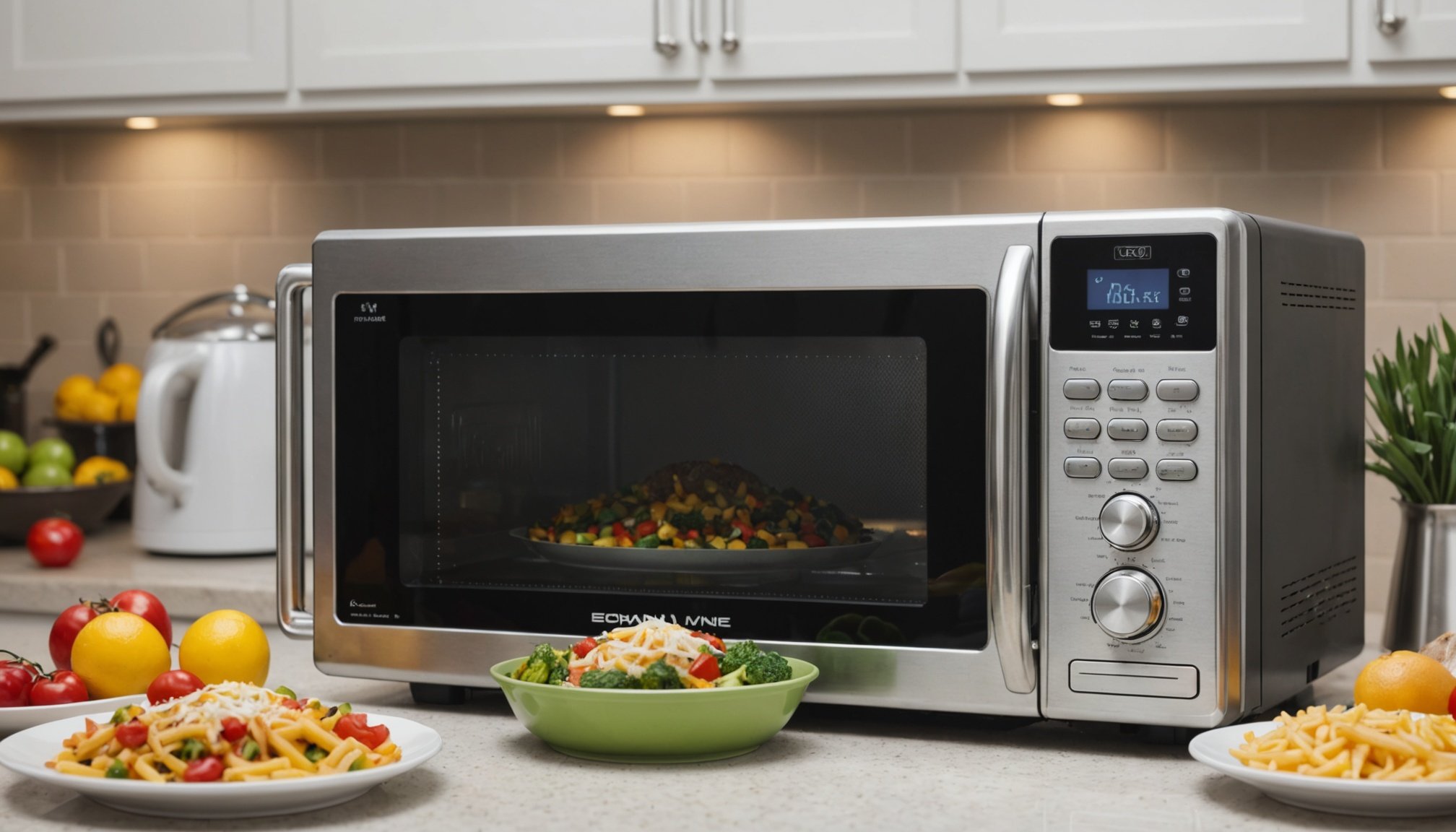Top Tips for Choosing a Low-Radiation Microwave: Smart and Safe Selections
When it comes to selecting a microwave, many of us focus on factors like cooking power, features, and price. However, with growing concerns about radiation exposure, it’s crucial to consider the safety aspect as well. Here’s a comprehensive guide to help you choose a low-radiation microwave that is both smart and safe for your kitchen.
Understanding Microwave Radiation
Before diving into the selection process, it’s essential to understand the basics of microwave radiation. Microwaves are a form of non-ionizing electromagnetic radiation, which is generally considered safe at typical exposure levels. However, high-intensity exposure can cause thermal effects, such as heating living tissue, and in extreme cases, can lead to adverse health effects like cataracts if the exposure is intense and prolonged[1][2].
Also read : Effortlessly chop garlic without the mess: the ultimate guide to choosing your ideal uniform-style chopper
Key Factors to Consider
When buying a microwave, several factors can help you make a safe and informed decision.
Power and Efficiency
- Cooking Power: Look for microwaves with adjustable power levels. While high power (e.g., 1200 watts) can cook food quickly, lower power settings can be safer and more energy-efficient for certain tasks.
- Inverter Technology: Microwaves with inverter technology, like the Panasonic Microwave Oven, provide consistent power levels, which can reduce the risk of hot spots and uneven cooking[5].
Safety Features
- Child Safety Lock: A child safety lock is a must-have to prevent accidental starts and ensure the microwave is not used by children without supervision.
- Sensor Cooking: Features like sensor reheat and defrost can help prevent overcooking, which reduces the risk of excessive radiation exposure[5].
Design and Build
- Counter Space: Consider the size of the microwave in relation to your available counter space. Compact models like the Commercial Chef Countertop Microwave are ideal for smaller kitchens[5].
- Stainless Steel Interior: A stainless steel interior is easier to clean and can reduce the risk of food residue causing uneven heating.
Best Microwaves for Low Radiation
Here are some top picks that balance performance with safety:
In parallel : The ultimate handbook for choosing a reliable and multifunctional mandoline slicer
Panasonic Microwave Oven with Inverter Technology
- Power: 1200 watts
- Features: Sensor reheat, defrost, child safety lock
- Safety: Inverter technology for consistent power, reducing hot spots
- Price: Around $200
- Why It’s Good: The Panasonic NN-SN65KB Microwave Oven is known for its even heating and safety features, making it a top choice for those concerned about radiation[5].
Commercial Chef Countertop Microwave
- Power: 900 watts
- Features: Simple controls, express cook buttons, child safety lock
- Safety: Compact size reduces overall radiation exposure, easy to use
- Price: Under $100
- Why It’s Good: This budget-friendly option is perfect for small kitchens and offers a safe, easy-to-use design[5].
Toshiba Microwave Oven EC042A5C-SS
- Power: 1000 watts
- Features: Convection mode, speed cooking mode, sensor to prevent overcooking
- Safety: Multiple cooking modes reduce the need for high power settings
- Price: Around $150
- Why It’s Good: The Toshiba Microwave Oven offers versatile cooking options, including convection mode, which can help distribute heat more evenly and safely[5].
Detailed Comparison Table
Here’s a comparison table to help you view the key features and safety aspects of these microwaves at a glance:
| Microwave Model | Power (Watts) | Safety Features | Additional Features | Price Range |
|---|---|---|---|---|
| Panasonic NN-SN65KB | 1200 | Child safety lock, sensor reheat | Inverter technology, preset buttons | $200 |
| Commercial Chef Countertop | 900 | Child safety lock, express cook | Simple controls, compact size | Under $100 |
| Toshiba Microwave Oven EC042A5C-SS | 1000 | Sensor to prevent overcooking | Convection mode, speed cooking mode | $150 |
| LG NeoChef MSER1590S | 1200 | Sensor to prevent overcooking | Touchpad controls, microwave sensor | $250 |
| GE Smart Microwave with Scan-to-Cook | 1000 | Child safety lock, sensor cooking | Smart features, scan-to-cook | $200 |
Practical Tips for Safe Microwave Use
Here are some practical tips to ensure safe and efficient use of your microwave:
Use Microwave-Safe Containers
- Always use containers that are labeled as microwave-safe to avoid the risk of chemical leaching or the container melting and causing harm[2].
Avoid Overcooking
- Use the sensor cooking features to prevent overcooking, which can lead to excessive radiation exposure and uneven heating.
Keep the Microwave Clean
- Regularly clean the interior of the microwave to prevent food residue from causing hot spots and uneven heating.
Follow Instructions
- Always follow the cooking instructions provided with the microwave and the food packaging to ensure safe and efficient cooking.
Common Misconceptions About Microwave Radiation
There are several misconceptions about microwave radiation that need to be addressed:
Ionizing vs. Non-Ionizing Radiation
- Microwaves are non-ionizing radiation, which lacks the energy to cause severe biological damage like ionizing radiation (e.g., X-rays and gamma rays)[2].
Health Risks
- While high-intensity microwave exposure can cause thermal effects, typical household use does not pose significant health risks. However, it’s crucial to follow safety guidelines and use the microwave responsibly[1][2].
Public Outreach and Education
Public outreach and education are vital in dispelling myths and promoting scientific literacy about electromagnetic radiation. Here’s what experts say:
-
“Understanding the distinction between ionizing and non-ionizing radiation is crucial for accurately assessing the health risks associated with various forms of EMR exposure,” notes a comprehensive review on electromagnetic radiation[2].
-
“Accurate information from trusted sources can help dispel myths and ensure that the public understands the benefits and limitations of technologies that rely on EMR,” emphasizes another study[2].
Choosing a low-radiation microwave involves considering several key factors, including power efficiency, safety features, and design. By understanding the basics of microwave radiation, selecting the right model, and following practical tips for safe use, you can ensure that your microwave is both smart and safe for your kitchen.
Here’s a final checklist to keep in mind:
- Power and Efficiency: Look for adjustable power levels and inverter technology.
- Safety Features: Ensure the microwave has a child safety lock and sensor cooking features.
- Design and Build: Opt for a stainless steel interior and consider the size in relation to your counter space.
- Practical Tips: Use microwave-safe containers, avoid overcooking, keep the microwave clean, and follow instructions.
By following these guidelines, you can enjoy the convenience of microwave cooking while minimizing the risks associated with radiation exposure.










